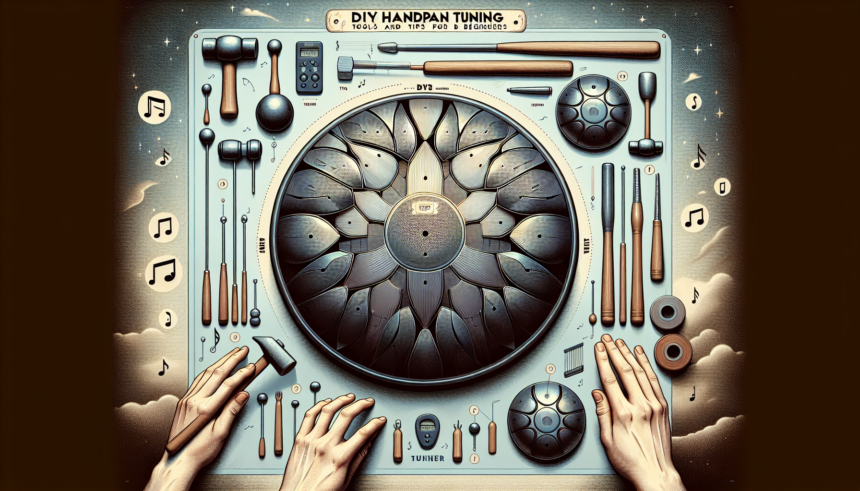<!DOCTYPE html>
<html lang="en">
<head>
<meta charset="UTF-8">
<meta name="viewport" content="width=device-width, initial-scale=1.0">
<title>DIY Handpan Tuning: Tools and Tips for Beginners</title>
<style>
body {
font-family: Arial, sans-serif;
line-height: 1.6;
margin: 20px;
color: #333;
}
h2 {
color: #005c99;
}
h3 {
margin-top: 20px;
color: #0073e6;
}
p {
margin-bottom: 10px;
}
ul {
margin-bottom: 20px;
list-style: disc;
padding-left: 20px;
}
faq-section {
margin-top: 30px;
background-color: #f9f9f9;
padding: 20px;
border-radius: 5px;
}
</style>
</head>
<body>
<h2>Introduction</h2>
<p>The handpan is a captivating instrument known for its ethereal sound and meditative qualities. While playing the handpan is a soothing experience, many enthusiasts are keen on learning to tune it themselves. Tuning a handpan can seem daunting at first due to its complex structure, but with the right tools and techniques, even beginners can master the skill. This article will guide you through the necessary tools and provide tips to get started with handpan tuning on your own.</p>
<h2>Understanding Handpan Tuning</h2>
<p>Before delving into the process of tuning, it's essential to comprehend what makes a handpan resonate with its unique sound. Handpans are crafted from nitrided steel, and their sound comes from the precisely tuned dimples and domes. Each note area is crafted to produce a specific pitch, and the balance of overtones and harmonics plays a critical role in the overall sound.</p>
<p>The art of handpan tuning requires an ear for music, patience, and precision. The central note, or "ding," and the surrounding tones must be in harmony, and even minor discrepancies can affect the instrument's voice.</p>
<h3>Essential Tools for Tuning</h3>
<p>Equipping yourself with the right tools is a fundamental step in your handpan tuning journey. Here is a list of essential tools to have:</p>
<ul>
<li><strong>Electronic Tuner:</strong> A high-quality tuner is crucial for identifying the precise pitch of each note. Choose a chromatic tuner with a wide frequency range to accommodate all necessary notes.</li>
<li><strong>Rubber Mallets:</strong> Different sizes and weights of rubber mallets help in adjusting the notes with gentle impacts. They provide control when tweaking the domes without causing damage.</li>
<li><strong>Tuning Mics</strong>: These are small microphones placed near the handpan to capture sound accurately, ensuring your tuning is true to the desired frequency.</li>
<li><strong>Balancing Hammer:</strong> This tool helps in making minute adjustments to the steel's surface, balancing overtones, and fine-tuning each note's frequency.</li>
<li><strong>Protective Gear:</strong> Since tuning involves precision and potentially dealing with sharp tools and sound vibrations, safety gloves and noise-canceling headphones can be important.</li>
</ul>
<h3>Steps for Handpan Tuning</h3>
<p>The process of tuning a handpan involves several meticulous steps that require attention to detail and patience:</p>
<ol>
<li><strong>Initial Assessment:</strong> Begin by identifying which notes need tuning. Using an electronic tuner, play each note on the handpan and observe the tuner for any discrepancies in pitch.</li>
<li><strong>Sound Mapping:</strong> Map out the sound dynamics of your handpan, noting the specific overtones and harmonics produced by each note. This helps in understanding the overall frequency balance.</li>
<li><strong>Adjusting Notes:</strong> Use the rubber mallets gently to adjust the notes, either by increasing the pitch with minor indentations or flattening a raised surface to lower the pitch.</li>
<li><strong>Fine-Tuning:</strong> For precise adjustments, employ the balancing hammer to make incremental modifications to achieve a perfect balance between the principal tone and its overtones.</li>
<li><strong>Re-assessment:</strong> Continuously compare the sound of the handpan with your initial assessment. Use the tuning microphones for accurate sound capture and ensure every note aligns with its desired frequency.</li>
</ol>
<h3>Tips for Beginners</h3>
<p>Embarking on your handpan tuning journey can be challenging, but these tips should help ease the process:</p>
<ul>
<li><strong>Start with a Single Note:</strong> To build your confidence, begin by tuning a single note before moving onto the entire handpan. This gives you practice without feeling overwhelmed.</li>
<li><strong>Take Breaks:</strong> Tuning can be tiring, especially on your ears. Take regular breaks to rest and refresh, which allows you to return with a clearer perspective.</li>
<li><strong>Consistent Practice:</strong> Like learning any musical instrument, tuning requires practice. The more you practice, the better your ear will become at identifying subtle discrepancies.</li>
<li><strong>Seek Feedback:</strong> Share your progress with fellow handpan players or tuning experts. Constructive feedback can offer new insights and improve your skills.</li>
<li><strong>Document Progress:</strong> Keep a diary of your tuning sessions. Not only does this help track your improvement, but it also serves as a reference for future tuning tasks.</li>
</ul>
<h3>Conclusion</h3>
<p>Tuning a handpan is a fulfilling endeavor that offers the opportunity to deepen your connection with the instrument. While the path to mastering handpan tuning involves patience, dedication, and a careful approach, beginners are more than capable of learning and succeeding. By equipping yourself with the right tools and techniques, you can achieve a harmonious sound that enhances your musical journey. As you continue to practice and refine your skills, remember that each small step you take brings you closer to the mastery of this mystical instrument.</p>
<faq-section>
<h3>Frequently Asked Questions</h3>
<h4>1. Can I tune a handpan without any prior experience in music?</h4>
<p>Yes, you can tune a handpan without prior musical experience, although having an ear for music is advantageous. With dedication, practice, and guidance from tuners and musicians, you'll quickly develop the necessary skills.</p>
<h4>2. How often should I tune my handpan?</h4>
<p>The frequency of tuning depends on several factors, including how frequently you play and environmental conditions. Generally, handpans made from high-quality materials maintain their tuning better and may only require adjustments once or twice a year.</p>
<h4>3. What should I do if I accidentally damage my handpan during tuning?</h4>
<p>If damage occurs while tuning, it's best to consult a professional handpan tuner or manufacturer. Attempting to repair significant damage without expertise could worsen the condition of your instrument.</p>
<h4>4. Are there handpan tuning workshops available for beginners?</h4>
<p>Yes, many handpan communities and workshops provide beginner-friendly sessions. These are excellent opportunities to learn from experts and receive hands-on experience under guided supervision.</p>
<h4>5. Can all types of handpans be tuned manually?</h4>
<p>Most handpans can be tuned manually, but the ease of tuning can vary based on the design and materials of the instrument. It is advisable to check with the manufacturer or a tuning professional if you have a uniquely designed handpan.</p>
</faq-section>
</body>
</html>DIY Handpan Tuning: Tools and Tips for Beginners

Leave a comment




